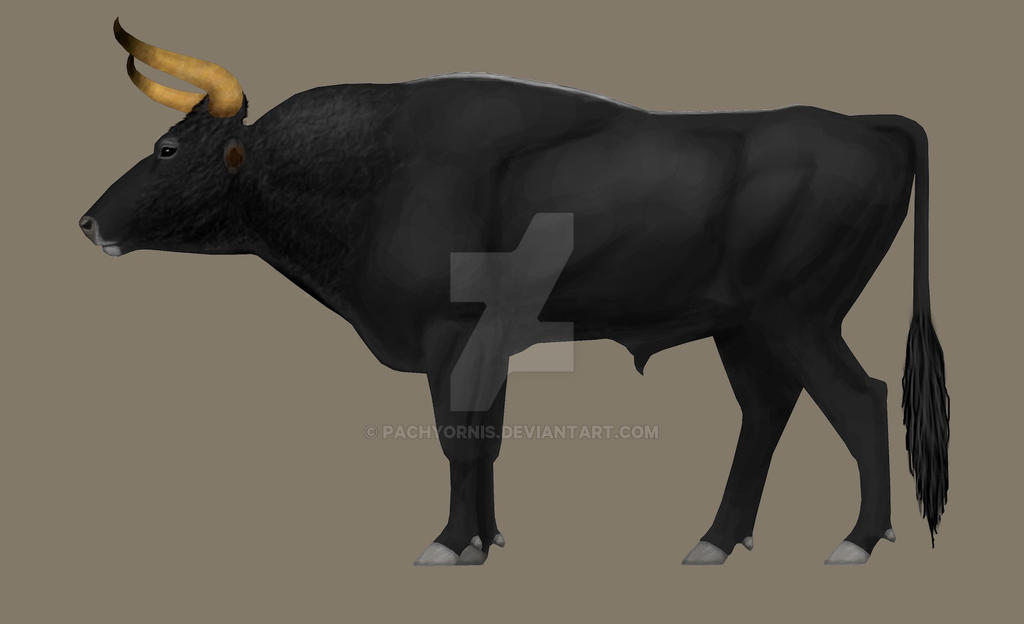I make no secret of the fact that I am not averse to using zebuine or zebuine-influenced cattle for “breeding-back” the European aurochs, Bos primigenius primigenius. Surely, zebus have undesired traits, such as the zebuine hump, hanging ears or the adaption to hot, arid climate and hence a coat that would be insufficient for European climate. But, on the other hand, they also have traits useful for “breeding-back” the European aurochs. And what is very interesting is that zebus seemingly share wildtype alleles with the European aurochs that taurine cattle have lost [1]. This could be the result of genetic drift (hence “coincidence”), or maybe zebus did indeed preserve some primitive organismic traits that taurine cattle have lost. I also consider the reverse possible, that taurine cattle have aurochs alleles that zebus lost, but that has not been proven genetically yet.
Thinking of useful traits that zebuine or zebuine-influenced breeds can contribute to “breeding-back” the European aurochs, the first trait that comes to mind are large horns. Watussi is or was used in some projects/breeds to achieve an aurochs-like horn volume. But there is an even more important trait that zebus could contribute that was not considered yet: an aurochs-like ratio of trunk length to shoulder height ratio (note: not withers height, that parameter is influenced by the height of the spines). In male aurochs the ratio was 1:1, in cows the trunk was even a little shorter. “Breeding-back” struggles to achieve that ratio – in Heck cattle the trunk is generally too long and the legs too short (with very few exceptions), I have also not seen a Tauros cattle individual with the right ratio yet, and also in Taurus cattle the ratio is not entirely as in the aurochs. For example, in the otherwise rather nice bull Darth Vader III, the legs are not long enough respectively the trunk is too long. In Lamarck, the best Taurus bull so far, the ratio comes closer to the aurochs. I used two photos to determine the ratio, one resulted in 1:1,07 and the other one in 1:1,16. In the cows, the trunk is usually longer than the shoulder height too although it should be slightly shorter.
 |
| The Taurus bull Lamarck - the shoulder height to trunk length ratio is not completely there yet |
This is not surprising, considering that many of the primitive taurine breeds from Europe are imperfect in this regard. Sayaguesa, a heavily used breed that has many qualities, often has rather longish or short-legged bulls. Also, in Chianina, some bulls have indeed the 1:1 ratio, others do not, it depends on the individual. Lidia bulls are generally too short-legged, with a few exceptions. Maronesa, a breed that is wonderfully aurochs-like in many respects, usually has rather heavy and longish bulls too. The ratio is not perfect in Maremmana either, the same goes for their Hungarian sister breed Grey cattle. An aurochs-like 1:1 ratio for bulls and shorter for cows is simply hard to find even in primitive taurine cattle.
 |
| A Deoni zebu bull, photo by Pavanaja on Wikimedia Commons |
But there are zebus with a very short trunk and pretty long legs, such as the breeds Deoni, Hallikar, Haryana, Kenkhatha, Nagori and others. I am aware of the fact that these breeds cannot be considered “aurochs-like” in the strict sense: they have the zebuine hump, a diluted coat colour, wrong horn shape, hanging ears and are of the wrong ecotype. But I am not suggesting to using these breeds on a large scale. Rather, it would be interesting to see a F2 crossed with Maronesa (or Sayaguesa or Taurus/Tauros). With luck, the right trunk to shoulder height ratio gets passed on in the F2 while maintaining a more or less aurochs-like overall habitus. An individual like that could be useful for further breeding. Undesired zebu traits would have to be bred out just as any undesired trait.
The only real problem would be to get hands on these zebus. I guess importing them from India would be way too effortful and perhaps impossible due to the official disease requirements. But perhaps there are zebu breeders in Europe already that have useful individuals. One would have to look for them.
References
[1] Orlando et al.: The first aurochs genome reveals the breeding history of British and European cattle. 2015.






